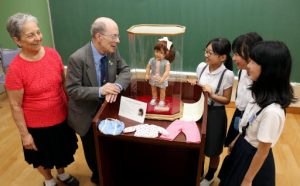American couple give blue-eyed doll to Hiroshima students as symbol of friendship
Jun. 1, 2019
by Kana Kobayashi, Staff Writer
Sidney Gulick III, 82, a professor at the University of Maryland, in the United States, visited Honkawa Elementary School in downtown Hiroshima on May 31 and gave a blue-eyed doll to the school. Mr. Gulick was accompanied by his wife Francis, 78, a mathematician. Mr. Gulick’s grandfather, who was a missionary, began sending blue-eyed dolls as a goodwill gesture to Japanese schools in the early Showa era (1926-1989). The couple met with 61 sixth graders and offered the doll as a symbol of their wish for peace.
The new doll, named Katy, is about 50 centimeters tall. Her brown hair is tied up on her head and she is wearing a pink shirt and a light blue skirt. Her bag contains an extra shirt and a pair of pants made by Ms. Gulick. Katy carries a passport that bears her name and date of birth.
Dr. Sydney Gulick (1860-1945) spearheaded the effort that sent about 13,000 dolls to schools across Japan in 1927. Among them, 326 dolls were sent to schools in Hiroshima Prefecture. At that time, a movement to drive out Japanese immigrants was growing stronger in the United States. Dr. Gulick was worried that the relationship between Japan and the United States would deteriorate. It is believed that the late businessman Eiichi Shibusawa, who is called the father of Japanese capitalism, supported Dr. Gulick’s effort.
But many of the dolls were disposed of during the war because they came from an enemy country. In Hiroshima Prefecture, a total of five dolls still exist in the cities of Fukuyama, Onomichi, and Kure.
Following in his late grandfather’s footsteps, Mr. Gulick and his wife began sending “new blue-eyed dolls” to elementary schools and kindergartens in Japan in 1987. So far they have sent 292 dolls, 22 of which have been sent to schools in cities in Hiroshima Prefecture that include Fukuyama and Kure.
At Honkawa Elementary School, Mr. Gulick related the history of the blue-eyed dolls to the students. He said to them in Japanese, “Everyone, please make friends with her.” Expressing their gratitude, the children sang the “Hiroshima Peace Song.”
Mr. Gulick hopes that children will feel that Katy is their friend while Ms. Gulick hopes that children will understand that they can share the same wish despite differences in their appearance.
After seeing the couple eye the students with affection, Noa Tanaka, 12, said, “Through the doll, I will keep telling about the preciousness of peace to younger students.”
(Originally published on June 1, 2019)
Sidney Gulick III, 82, a professor at the University of Maryland, in the United States, visited Honkawa Elementary School in downtown Hiroshima on May 31 and gave a blue-eyed doll to the school. Mr. Gulick was accompanied by his wife Francis, 78, a mathematician. Mr. Gulick’s grandfather, who was a missionary, began sending blue-eyed dolls as a goodwill gesture to Japanese schools in the early Showa era (1926-1989). The couple met with 61 sixth graders and offered the doll as a symbol of their wish for peace.
The new doll, named Katy, is about 50 centimeters tall. Her brown hair is tied up on her head and she is wearing a pink shirt and a light blue skirt. Her bag contains an extra shirt and a pair of pants made by Ms. Gulick. Katy carries a passport that bears her name and date of birth.
Dr. Sydney Gulick (1860-1945) spearheaded the effort that sent about 13,000 dolls to schools across Japan in 1927. Among them, 326 dolls were sent to schools in Hiroshima Prefecture. At that time, a movement to drive out Japanese immigrants was growing stronger in the United States. Dr. Gulick was worried that the relationship between Japan and the United States would deteriorate. It is believed that the late businessman Eiichi Shibusawa, who is called the father of Japanese capitalism, supported Dr. Gulick’s effort.
But many of the dolls were disposed of during the war because they came from an enemy country. In Hiroshima Prefecture, a total of five dolls still exist in the cities of Fukuyama, Onomichi, and Kure.
Following in his late grandfather’s footsteps, Mr. Gulick and his wife began sending “new blue-eyed dolls” to elementary schools and kindergartens in Japan in 1987. So far they have sent 292 dolls, 22 of which have been sent to schools in cities in Hiroshima Prefecture that include Fukuyama and Kure.
At Honkawa Elementary School, Mr. Gulick related the history of the blue-eyed dolls to the students. He said to them in Japanese, “Everyone, please make friends with her.” Expressing their gratitude, the children sang the “Hiroshima Peace Song.”
Mr. Gulick hopes that children will feel that Katy is their friend while Ms. Gulick hopes that children will understand that they can share the same wish despite differences in their appearance.
After seeing the couple eye the students with affection, Noa Tanaka, 12, said, “Through the doll, I will keep telling about the preciousness of peace to younger students.”
(Originally published on June 1, 2019)








